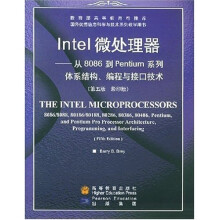1 Introduction to the Microprocessor and Computer
Introduction/Chapter Objectives
1-1 A Historical Background
1-2 The Microprocessor-Based Personal Computer System
1-3 Number Systems
1-4 Computer Data Formats
1-5 Summary
1-6 Questions and Problems
2 The Microprocessor and its Architecture
Introduction/Chapter Objectives
2-1 Internal Microprocessor Architecture
2-2 Real Mode Memory Addressing
2-3 Introduction to Protected Mode Memory Addressing
2-4 Memory Paging
2-5 Summary
2-6 Questions and Problems
3 Addressing Modes
Introduction/Chapter Objectives
3-1 Data-Addresing Modes
3-2 Program Memory-Addressing Modes
3-3 Stack Memory-Addressing Modes
3-4 Summary
3-5 Questions and Problems
4 Data Movement Instructions
Introduction/Chapter Objectives
4-1 MOV Revisited
4-2 PUSH/POP
4-3 Load-Effective Address
4-4 String Data Transfers
4-5 Miscellaneous Data Transfer Instructions
4-6 Segment Override Prefix
4-7 Assembler Detail
4-8 Summary
4-9 Questions and Problems
5 Arithmetic and Logic Instructions
Introduction/Chapter Objectives
5-1 Addition, Subtraction, and Comparison
5-2 Multiplication and Division
5-3 BCD and ASCII Arithmetic
5-4 Basic Logic Instructions
5-5 Shift and Rotate
5-6 String Comparisons
5-7 Summary
5-8 Questions and Problems
6 Program Control Instructions
Introduction/Chapter Objectives
6-1 The Jump Gorup
6-2 Controlling the Flow of an Assembly Language Program
6-3 Procedures
6-4 Introduction to Interrrupts
6-5 Machine Control and Miscellaneous Instructions
6-6 Summary
6-7 Questions and Problems
7 Programming the Microprocessor
Introduction/Chapter Objectives
7-1 Modular Programming
7-2 Using the Keyboard and Video Display
7-3 Data Conversions
7-4 Disk Files
7-5 Example Programs
7-6 Interrupt Hooks
7-7 Summary
7-8 Questions and Problems
8 Using Assembly Language with C/C++
Introduction/Chapter Objectives
8-1 Using Assembly Language with C/C++ for 16-bit Applications
8-2 Using Assembly Language with C/C++ for 32-bit Applications
8-3 Separate Assembly Objects
8-4 Summary
8-5 Questions and Problems
9 8086/8088 Hardware Specifications
Introduction/Chapter Objectives
9-1 Pin-Outs and Pin Functions
9-2 Clock Generator (8284A)
9-3 Bus Buffering and Latching
9-4 Bus Timing
9-5 Ready and the Wait State
9-6 Minimum Mode Verse Maximum Mode
9-7 Summary
9-8 Questions and Problems
10 Memory Interface
Introduction/Chapter Objectives
10-1 Memory Devices
10-2 Address Decoding
10-3 8088 and 80188 (8-bit) Memory Interface
10-4 8086, 80186, 80286, and 80386SX (16-bit) Memory Interface
10-5 80386DX and 80486 (32-bit) Memory Inteface
10-6 Pentium, Pentium Pro, and Pentium II (64-bit) Memory Interface
10-7 Dynamic RAM
10-8 Summary
10-9 Questions and Problems
11 Basic I/O Interface
Introduction/Chapter Objectives
11-1 Introduction to I/O Interface
11-2 I/O Port Address Decoding
11-3 The Programmable Peripheral Interface
11-4 The 8279 Programmable Keyboard/Display Interface
11-5 8254 Progammable Interval Timer
11-6 16550 Programmable Communications Interface
11-7 Analog-to-Digital (ADC) and Digital-to-Analog (DAC) Conversions
11-8 Summary
11-9 Questions and Problems
12 Interrupts
Introduction/Chapter Objectives
12-1 Basic Interrupt Processing
12-2 Hardware Interrupts
12-3 Expanding the Interrupt Structure
12-4 8259A Programmable Interrupt Controller
12-5 Interrupt Examples
12-6 Summary
12-7 Questions and Problems
13 Direct Memory Access and DMA-Controlled I/O
Introduction/Chapter Objectives
13-1 Basic DMA Operation
13-2 The 8237 DMA Controller
13-3 Shared-Bus Operation
13-4 Disk Memory Systems
13-5 Video Displays
13-6 Summary
13-7 Questions and Problems
14 The Arithmetic Coprocessor and MMX Technology
Introduction/Chapter Objectives
14-1 Data Formats for the Arithmetic Coprocessor
14-2 The 80X87 Architecture
14-3 Instruction Set
14-4 Programming with the Arithmetic Coprocessor
14-5 Introduction to MMX Technology
14-6 Summary
14-7 Questions and Problems
15 Bus Interface
Introduction/Chapter Objectives
15-1 The ISA Bus
15-2 The Extended ISA (EISA) and VESA Local Buses
15-3 The Peripheral Component Interconnect (PCI) Bus
15-4 The Universal Serial Bus (USB)
15-5 Accelerated Graphics Port (AGP)
15-6 Summary
15-7 Questions and Problems
16 The 80186, 80188, and 80286 Microprocessors
Introduction/Chapter Objectives
16-1 80186/80188 Architecture
16-2 Programming the 80186/80188 Enhancements
16-3 80C188EB Example Interface
16-4 Introduction to the 80286
16-5 Summary
16-6 Questions and Problems
17 The 80386 and 80486 Microprocessors
Introduction/Chapter Objectives
17-1 Introduction to the 80386 Microprocerssor
17-2 Special 80386 Registers
17-3 80386 Memory Management
17-4 Moving to Protected Mode
17-5 Virtual 8086 Mode
17-6 The Memory Paging Mechanism
17-7 Introduction to the 80486 Microprocessor
17-8 Summary
17-9 Questions and Problems
18 The Pentium and Pentium Pro Microprocessors
Introduction/Chapter Objectives
18-1 Introduction to the Pentium Microprocessor
18-2 Special Pentium Registers
18-3 Pentium Memory Management
18-4 New Pentium Instructions
18-5 Introduction to the Pentium Pro Microprocessor
18-6 Special Pentium Pro Features
18-7 Summary
18-8 Questions and Problems
19 The Pentium II Microprocessor
Introduction/Chapter Objectives
19-1 Introduction to the Pentium II Microprocessor
19-2 Pentium II Software Changes
19-3 Summary
19-4 Questions and Problems
Appendix A The Assembler, Disk Operating System, Basic I/O System, Mouse, and DPMI Memory Manager
Appendix B Instruction Set Summary
Appendix C Flag-Bit Changes
Appendix D Answers to Selected Even-Numbered Questions and Problems

